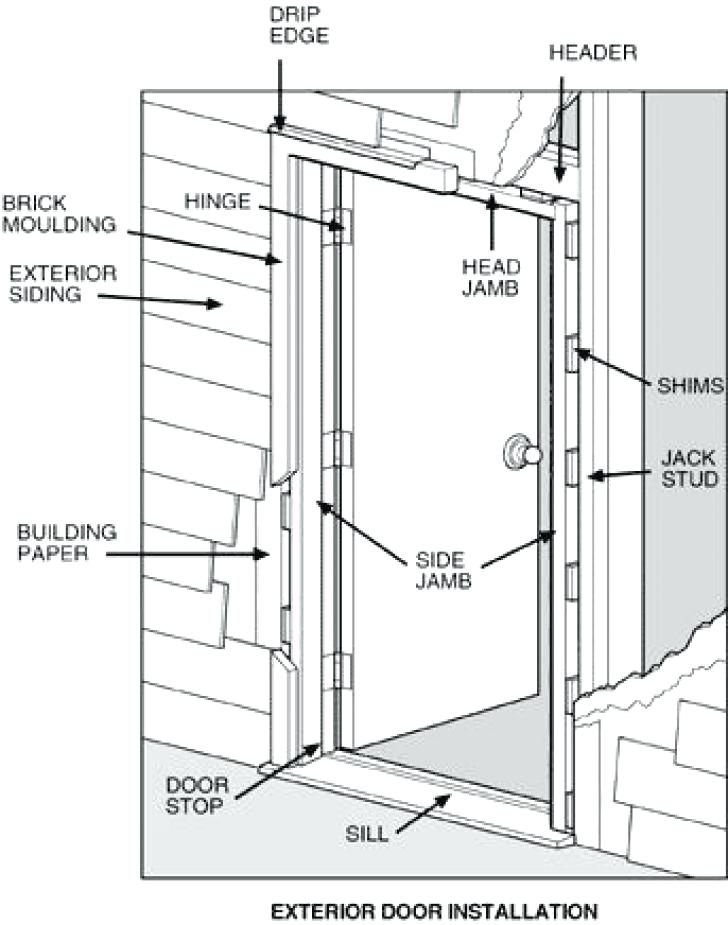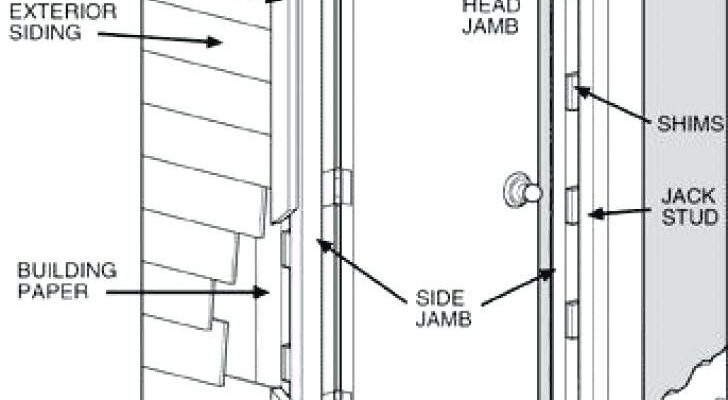
Let me explain why this matters: fiberglass doors, like those made by Therma-Tru or Masonite, are a popular choice because they’re tough, energy-efficient, and weatherproof. But they don’t always come with those neat, pre-drilled holes for your hardware. That means you’ve got to create precision cutouts and handle fiberglass—a material that’s sturdy but needs some special care. If you’ve ever “eyeballed it” with a power drill, you know things can go sideways fast. The good news? With some prep and the right approach, you can get professional results from your DIY effort.
What Makes Fiberglass Doors Different from Wood or Steel?
First off, let’s get clear on why preparing a fiberglass door for new hardware is a separate beast from working with wood or steel. Fiberglass is made of glass fibers embedded in resin, which makes it lightweight but surprisingly strong. On the upside, it won’t warp or rot like wood, and it doesn’t rust like steel. But on the downside, it’s less forgiving if you make a mistake—chips, cracks, or messy holes will haunt you every time you walk by.
With wood doors, you can fudge a little with a chisel or sandpaper. Mess up on steel, and it’s tough but at least predictable—drill slow, and you’re good. Fiberglass, though, can splinter or “fuzz” around the drill site unless you use the right bit, speed, and pressure. Honestly, treating fiberglass like it’s just another wood project is the fastest route to regret.
You might be wondering: does this mean I need pro-level tools and skills? Not at all. What it does mean is that you should take a beat, use a steady hand, and follow a process made for fiberglass. That’s how you end up with clean, snug holes, not ragged edges that look like you fought the door and lost.
Choosing the Right Tools and Materials for Fiberglass
Here’s the truth: using the right tools for prepping a fiberglass door isn’t some snobby pro tip, it’s just common sense. For starters, you’ll need a hole saw sized for your lockset (typically 2-1/8 inches for the main bore and 1 inch for the latch), plus a power drill. Regular wood bits won’t cut it—literally. Use carbide-tipped hole saws or those labeled for “multi-material” work.
Grab a tape measure, a pencil, a combination square, and some painter’s tape. The painter’s tape is a real trick: it helps prevent the fiberglass from splintering at the edge of your hole. You’ll also want a dust mask and safety glasses, because breathing in fiberglass dust is nobody’s idea of fun.
Here’s a quick rundown of what you should have before starting:
- Carbide-tipped hole saw (2-1/8″ and 1″)
- Electric drill (corded is fine, cordless if it’s powerful enough)
- Painter’s tape for marking and protecting the surface
- Accurate tape measure—don’t trust your eyeball here
- Combination square or level for straight lines
- Eye and breathing protection
- Wood or scrap block for backing the drill site (optional but helpful)
Don’t try to substitute or skip steps. Cutting corners leads to splintered fiberglass and a world of frustration. If you treat your tools and steps with respect, you’ll get a much cleaner, safer result.
Measuring and Marking: Double-Check Before You Drill
You know that old carpenter phrase, “Measure twice, cut once?” It’s gospel here. With a fiberglass door, every hole is final. So take your time with this step.
Start by holding up the hardware template (usually included in the kit) to the door at the standard height—most locks sit 36 inches from the floor, but check what feels natural for you. Align the template’s center with the door’s edge and tape it in place. Then, use your combination square to check that everything is perfectly straight. A slightly crooked deadbolt isn’t just ugly—it can jam or wear out fast.
Use a pencil to mark the hole locations—main bore for the lock and the smaller latch hole at the edge. I like to put painter’s tape on the door, then mark on the tape. It gives me a clear guide, and the tape helps prevent chips.
Double-check: is the template level? Is it at a comfortable height? Did you account for the door’s swing direction? Flipping the template upside down by mistake is more common than you’d think. If something looks off, redo it. A few extra minutes here will save hours of regret and troubleshooting later.
Drilling Clean Holes in Fiberglass (Without Pre-Bore)
Okay, here’s where things get real. Drilling into fiberglass is where most people get nervous, and for good reason. But if you set yourself up right, the result will look factory-made.
First, stick painter’s tape over the marked area. This helps hold the fiberglass fibers in place and keeps the hole edge crisp. Start with a small pilot hole—something like 1/8 inch—right at the center mark, just deep enough to guide your hole saw. The pilot hole keeps the saw from wobbling all over your door.
Attach your hole saw to the drill and line it up with that pilot hole. Go slow and steady—don’t punch through like you’re racing the clock. Let the saw do the work, applying gentle, even pressure. If you’re feeling fancy, clamp a scrap piece of wood behind the door at the drill site; this helps prevent blowout on the back side.
Once through, check the edges. If you see fuzz or splinters, a quick pass with fine sandpaper (never aggressive) can smooth things out. For the latch hole, repeat the process on the door’s edge—again, slow and steady wins the race.
Pro tip: Keep your drill speed low and steady. High speed heats up the fiberglass and can melt or burn the resin, making a rough, sticky mess.
Dealing with Insulation, Core Material, and Thin Door Skins
Here’s the thing: not all fiberglass doors are constructed the same way. Some have solid cores, while others are hollow with insulation inside. If you hit foam or a honeycomb core, don’t panic—it’s normal. But you need to be careful not to crush the core material around the hole, which could affect how well the hardware fits.
For doors with thin fiberglass skins over insulation, you might want to reinforce the area around the bore. Some folks cut a ring from a scrap of plywood or buy a door hole reinforcement plate. Place this behind your hardware or between the skin and lock, and you’ll avoid that “squishy” feeling when the lock tightens down.
A solid core door gives you more leeway, but you should still avoid over-tightening screws. Stripping out the hole or crushing the fiberglass is a sure way to need a reset or replacement hardware down the line. Always follow your hardware’s instructions for recommended torque and anchoring methods. If something doesn’t fit tightly, don’t be tempted to just jam in battery-powered screwdrivers and hope for the best—troubleshooting a ruined hole is way harder than a little extra work upfront.
Installing New Hardware Into a Freshly Drilled Fiberglass Door
Once your holes are drilled and edges are clean, it’s time to install the hardware—maybe a Schlage deadbolt, a Kwikset lock, or even a smart lock with fire code compliance. Whatever your brand, the process is basically the same.
Start by inserting the latch into the edge hole. Make sure it sits flush. If it sticks out or wobbles, sand carefully or check for leftover insulation in the way. Next, feed the lock cylinder through the main bore, aligning it with the latch. Sometimes you have to wiggle things into position, but don’t force it—if it’s not fitting easily, something is off with the alignment.
Tighten the screws by hand. If you overtighten, especially on a hollow or insulated door, you’ll risk crushing the fiberglass or strip the holes. Some hardware brands even include plastic spacers or support rings for this reason—use them if provided.
If you’re pairing a smart lock, remember to check battery orientation, test the code and sync features, and follow the brand’s installation guide carefully. Skip any troubleshooting shortcuts. With everything secured and the latch working smoothly, take a step back and test the handle and deadbolt through several open-close cycles. Listen for any scraping, catching, or stiffness. If you notice issues, stop and reset—don’t ignore them, or you’ll pay for it later.
Finishing Touches: Sealing, Painting, and Preventing Damage
When you’re done with the heavy lifting, there are a few finishing touches that are worth the effort. First, check that all exposed fiberglass edges inside the bore holes are sealed. A quick bead of exterior-grade caulk will keep moisture and air from sneaking into your door, which is especially important if you live somewhere wet or drafty.
If you plan to paint or stain your fiberglass door, make sure to touch up around the hardware openings, but only after the hardware is fully installed and you’ve masked off any sensitive surfaces. Painting over fresh caulk? Give it enough time to cure.
Use a clean cloth to wipe away dust, fingerprints, or leftover adhesive from the painter’s tape. Don’t skip this—it’s the difference between a “DIY” look and a professional finish.
Finally, step back and inspect your work. Are the lock and handle sitting flush? Is the action smooth and reliable every time you test the code or unlock with the remote (if you’ve installed smart hardware)? If yes, congrats—you just nailed one of the trickiest parts of home improvement.
Troubleshooting Common Problems When Preparing Fiberglass Doors
Even if you do everything right, things can still feel off. Here are a few common headaches you might run into—and what to do about them.
- Uneven hole edges or splintering: This usually happens when drilling too fast, using a dull bit, or skipping the painter’s tape. Sand lightly, then use a matching touch-up kit or caulk to smooth things over.
- Hardware won’t fit or align properly: Don’t force it. Check your measurements and the angle of the bore. Sometimes, a tiny bit of extra sanding is all you need. If the latch doesn’t reach, check if insulation or core material is blocking the way.
- Door feels “soft” around the holes: This means the core isn’t supporting the hardware well. Add a reinforcement plate or rings for extra strength and stability.
- Lock action is sticky or jammed: Remove the hardware, check for debris, and confirm everything is straight and flush. If you’ve installed a smart lock, reset the pairing and test the code or battery if the electronics aren’t responding.
Honestly, the best troubleshooting tool you have is patience. Take your time, test every step, and don’t be afraid to backtrack if something isn’t right. With fiberglass, the goal is always clean, snug, and solid—not fast and loose.
Wrapping Up: Getting Pro Results With Your New Fiberglass Door Hardware
Prepping a fiberglass door for new hardware might seem like a big job, but with the right steps, it’s totally doable—even for beginners. The trick is to respect the material, double-check every measurement, and take things slow. Whether you’re putting in a classic Kwikset handle or syncing a modern smart lock, a little extra care at each step makes all the difference.
Keep in mind: fiberglass doors last decades, so it’s worth doing it right the first time. You’ll end up with a door that not only works great but looks like it came right from the factory—no awkward gaps, no splinters, and no regrets.
So next time you’re staring at that blank, hole-free door, remember: you’ve got all the tools, tips, and confidence you need to get it just right. Your front door deserves hardware that feels solid and safe every time you use it—and now, you know exactly how to get there.
